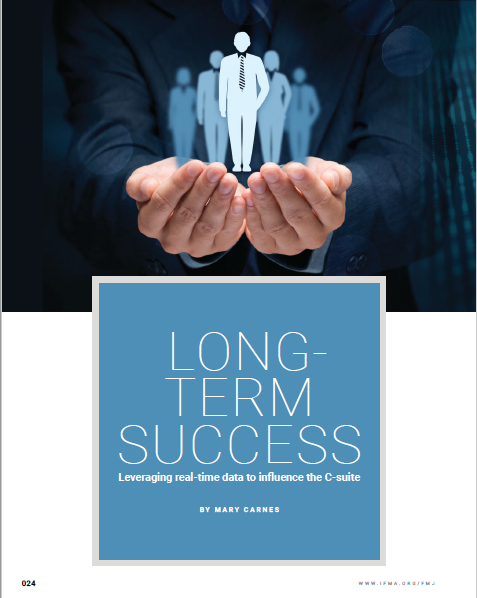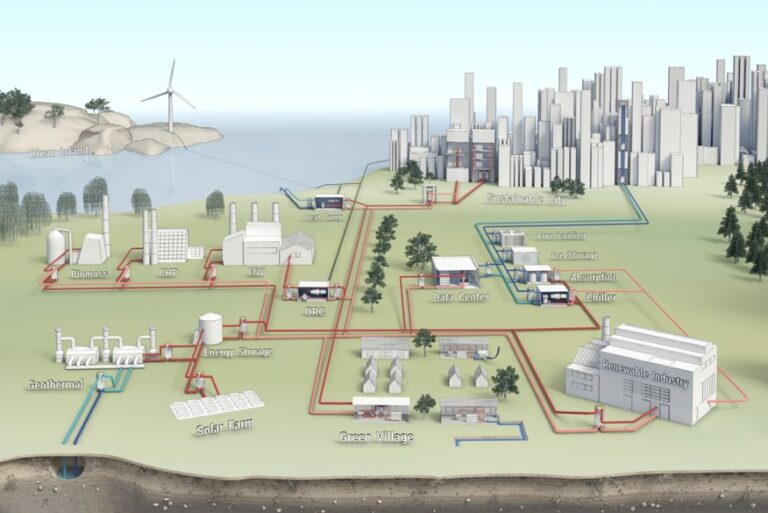This article originally appeared in the November/December 2022 issue of FMJ
By Mary Karnes — Workplace metrics have radically changed since the pandemic. And so have the way that facility managers gather and use them. Most workplaces today are increasingly flexible and dynamic, complicating space decisions on both the facilities and C-suite level. While this flexibility is necessary for achieving business goals and addressing changing employee needs, it also comes with a challenge and a cost.
 The challenge? For the C-suite to make informed decisions about the workplace, FMs need to present them with actionable data by combining multiple, real-time data sources into meaningful reports.
The challenge? For the C-suite to make informed decisions about the workplace, FMs need to present them with actionable data by combining multiple, real-time data sources into meaningful reports.
And the cost? Without good space planning, a hybrid office can easily lead to unused or unoccupied real estate, resulting in wasted space and resources. But with office transformations costing up to US$290 per square foot according to JLL’s 2022 U.S. & Canada Fit Out Guide, making changes without careful planning can be equally wasteful.
What data should FM teams gather in order to help the C-suite optimize the hybrid workplace while remaining agile? And what types of reports will show what’s really happening on the ground?
Analytics are more important than ever
Space planning was a relatively simple process before the pandemic. Although bookable desks and working from home were on the rise, they certainly were not the norm. Everyone consistently using the office created a stable work environment across time and location.
Now, with hybrid work so prevalent, the office is no longer the default place where work gets done. Employees are enjoying flexibility that allows them to come in on different days, for a variety of different reasons and activities. Leadership in turn needs to determine how best to align this desire for more flexibility with their current and future space needs.
But given this new complexity, the C-suite may not have a clear picture of what is actually happening in the workplace. To effectively navigate these challenges, they need visibility into the office, with data pulled from multiple sources in real time. Organizations are relying on data rather than dogma to plan ahead.
Armed with this data, leadership can remain agile and make more informed operational decisions, more strategic real estate decisions, and dramatically improve employee experience.
Moreover, the types of data the C-suite will need to access has expanded —desk bookings alone do not provide enough data to generate what’s necessary to make insightful decisions about a space. Only by merging multiple data sources — like employee feedback, desk and space bookings, calendars, floorplans, badge swipes, and more — can FMs avoid silos and present a more holistic view into their workplace.
The more dynamic the workplace, the greater the need for analytics, and the more leadership will be turning to their FM teams for insights. In other words, FMs are finding that leadership needs a lot more context now than ever before.
Ask the right questions to get the right data
Gathering the right workplace data always starts with asking the right questions. Data is not all made equally, and the burden of proof for data is getting higher, as companies are finding that desk booking information alone can be somewhat incomplete or have a margin of error. Getting a clear picture of real employee presence requires FMs to merge many different data sources to see what is actually happening at the workplace.
Specifically, the following five questions can inform what metrics FMs should be collecting to help the C-suite more fully understand their current hybrid reality.
1. Now that the office has re-opened, how many people are actually coming in?
Many companies have mandated return-to-office strategies, but just as many employees have been pushing back against inflexible requirements. In response, leadership may be working on ways to entice people back into the office, putting perks like free lunches, transit subsidies, and subsidized daycare on the table. But are these incentives working? Are employees actually coming in?
In the short term, metrics like daily attendance, desk utilization, and no-show rates can inform what is working and what is not in terms of drawing people back to the office.
In the long term, occupancy rates also give leadership a clearer picture of the wider trends taking place in the workplace, and whether there is enough space for those employees who are actually coming in.
2. Who is coming into the office, and when? What teams and departments come in most?
Of course the C-suite wants to invest in what people need when they are coming into the workplace. But different teams need different office configurations and amenities; folks in the product and engineering departments might need dual monitors and whiteboards, for example, while sales might need private spaces to meet with clients.
Gathering data on who is booking desks by department, location and space type will help leadership create an office that is fit for the people who are actually using it, which is how Daniel Santiago, Peloton’s Director of Workplace Operations.
“We compare the number of people pre-booking office visits to the number of people who actually use desks in each office neighborhood,” said Santiago. “And we use that data to improve desk utilization and allocation throughout the company. For example, if the content team is requesting 100 desks, we can provide 60 percent of that and re-allocate those seats to other teams if they aren’t fully utilized.”
FMs can use this type of data to help leadership adjust desk booking allocations for specific teams. Meanwhile, daily and weekly attendance metrics can also clarify where there may be days or times when the office is nearing capacity — or when most people are working from home. This allows leadership to adjust both the office layout, and their policies around hybrid work schedules, as necessary.
3. Is there enough of the right types of working spaces for people who come into the office?
Leadership needs to know what seating type is the most popular, so that they can cater towards those employee preferences. Combining occupancy and desk booking reports helps ensure that you not only have enough space for employees, but the right types of spaces, too.
While companies should continue to survey employees to capture sentiment, the reality is that employees are not always the best predictors of their own future behavior. Having accurate data that allows you to test, learn, and stay responsive to ever-changing employee needs will help to create a more productive and cost-effective workplace and a better overall employee experience.
“We use data to inform our financial projections,” said Santiago. “For example, the fiscal forecast of what we expect to spend is driven by how many people are booking desks and the usage trends in each neighborhood. But it can also help with simple tasks like refining our food and beverage program; I can project a line item based on the headcount and engagement that we’re seeing.”
4. Beyond desks, do we have the right meeting spaces for our employees to collaborate effectively?
There is some collaboration that just cannot happen over Zoom, which is why in a hybrid setting, the physical office is now often used for collaboration, teamwork and mentorship. According to VergeSense’s 2022 State of the Workplace Data Report, the average amount of office space per floor being used for collaborative spaces has almost doubled since the start of the pandemic. In-office employees now need access to a host of well-planned collaborative spaces — huddle rooms, war rooms, traditional conference rooms, break rooms and even game rooms all fit the bill.
If leadership wants to make the office more of a collaboration hub, they need data around utilization, busiest hours, and popularity of rooms and room types, so they can create spaces to fit actual demand.
FMs can also gather data on current room bookings to determine how much demand there is for each type of collaborative space: are employees fighting over certain types of meeting spaces? Or are some rooms sitting empty, even when booked?
5. Do costs and space allocations compare across sites?
Real estate data and space allocation reports have always been needed to optimize portfolios. But it is much more challenging to keep a pulse on what is actually happening across a hybrid and/or distributed environment.
Plus, more companies are actively trying to shrink their real estate footprint, requiring more detailed reports than ever before. According to the CBRE, about 52 percent of US companies are expecting to reduce their office space over the next three years.[1]
“When you’re coming into potential economic headwinds, that puts even more pressure on figuring out where you can cut expenses, so any resource that you’re not fully utilizing is a target for companies,” Mark Ein, chairman of Kastle, told The Wall Street Journal.
To make these big ticket investment decisions, leadership will need metrics like lease costs, average cost per employee, annual costs, space utilization by location, overall capacity, desk counts and current and potential density to ensure they are maximizing available space.
These types of metrics can also be compared floor by floor, or even workspace by workspace, helping fuel better decisions on a more granular level. This is how Santiago helped leadership keep real estate in line with actual space needs, even during rapid growth.
“We had all these different teams that were growing their headcounts so quickly,” he said. “Analytics empowered us to look at usage trends and determine what made the most sense in terms of space allocation. From there, we were able to confidently procure a lot of those different spaces for our teams. We can also answer questions like ‘How well have we activated each space? Did we rent out too much? Or did we lease too little?’ And we’re using that data to drive our next level of expansion.”
Give the C-suite the full picture with comprehensive reports
These five questions are just the starting point. FMs must be able to pull flexible data from multiple sources and present it in a manner that suits the types of decisions that leadership is trying to make. The data should be real-time in order to remain agile, so that FM teams can share it on a regular basis, while also pulling ad hoc reports as needed.
When FMs are able to provide timely, accurate data to the C-suite, the leadership team can then incorporate these insights into their long term planning process. This makes FMs invaluable partners to the executive team. Ultimately, the real-time reports they assemble and present, along with the insights gained from the data generated, enables companies and their workplaces to be more responsive and adaptable.
The end result? Happier employees, more productive workspaces, seamless hybrid working and adaptable, future-proof facilities.
[1] https://www.wsj.com/articles/companies-plan-additional-cuts-to-office-space-amid-looming-downturn-11657186201





